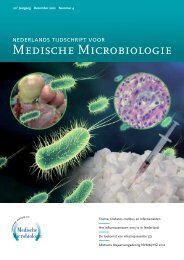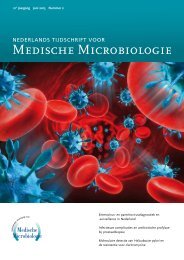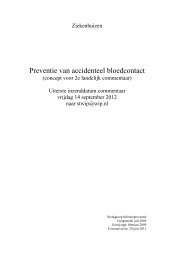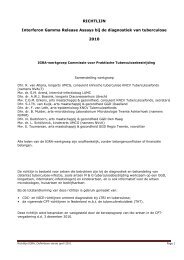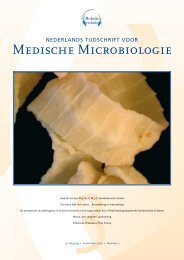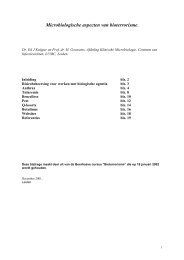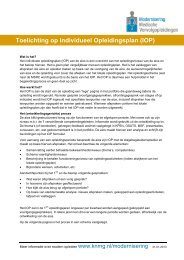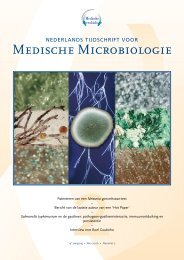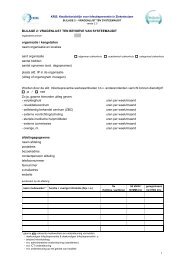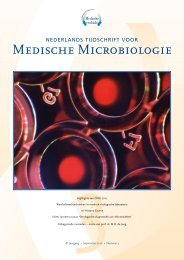Supplement bij veertiende jaargang, april 2006 - NVMM
Supplement bij veertiende jaargang, april 2006 - NVMM
Supplement bij veertiende jaargang, april 2006 - NVMM
Create successful ePaper yourself
Turn your PDF publications into a flip-book with our unique Google optimized e-Paper software.
14.01<br />
A genome-scale model of Lactobacillus plantarum WCFS1:<br />
useful for omics data integration and exploring metabolic<br />
capacities<br />
B. Teusink 1,2,3 , A. Wiersma 1,2 , D. Molenaar 1,2 , C. Francke 1,3 ,<br />
W.M. De Vos 1,4 , R.J. Siezen 1,2,3 , E.J. Smid 1,2<br />
1 Wageningen Centre for Food Sciences, Wageningen, 2 NIZO<br />
food research, Ede, 3 Radboud University, Center for Molecular<br />
and Biomolecular Informatics, Nijmegen, 4 Wageningen<br />
University, Microbiology, Wageningen<br />
Systems biology took off because of the omics revolution,<br />
confronting biologists with the need of models for data<br />
integration, analysis, and - ultimately - understanding of<br />
the complexity of biological systems. Hence, if we want to<br />
make optimal use of functional genomics data, we need<br />
models of genome scale. We have built a genome-scale<br />
metabolic model of Lactobacillus plantarum WCFS1, an<br />
important industrial lactic acid bacterium, both for food<br />
and health applications. The complete model currently<br />
consists of 546 unblocked internal reactions and 434<br />
corresponding metabolites, 97 exchange reactions, and 721<br />
genes (23.5% of the genome). The model is based on bioinformatics,<br />
comparison with other genome-scale models,<br />
literature, and in-house generated experimental evidence<br />
for the presence of pathways. Interactive metabolic maps<br />
have been generated, enabling data projection onto these<br />
maps. Chemostat experiments were run to generate physiological<br />
data for model construction and validation. Fluxes<br />
and biomass composition were measured. From this data,<br />
maintenance and growth-associated ATP consumption<br />
rates were estimated. Using Flux Variability Analysis,<br />
we found a remarkable flexibility in ATP-producing and<br />
ATP-consuming pathways, including 28 futile cycles<br />
detected by genome-scale elementary flux mode analysis.<br />
Optimization of an objective function – referred to as flux<br />
balance analysis (FBA) – has been often used to predict flux<br />
distributions in metabolic networks, but it fails miserably<br />
in L. plantarum. Rather than predicting flux distributions,<br />
FBA does appear useful in L. plantarum for exploring<br />
potential contributions to metabolic objectives, such as<br />
ATP generation or biomass yield.<br />
14.02<br />
Culture-independent approaches to elucidate biodiversity<br />
and population dynamics in complex microbial ecosystems<br />
of food fermentations and the intestinal tract<br />
G. Huys<br />
Laboratory of Microbiology, Faculty of Sciences, Ghent<br />
University, Ghent, Belgium<br />
Introduction: In recent years, DNA-based cultureindependent<br />
techniques have opened interesting perspec-<br />
Ned Tijdschr Med Microbiol <strong>2006</strong>; 4:<strong>Supplement</strong><br />
S47<br />
tives to unravel the composition and population dynamics<br />
of microbial communities in various environments.<br />
Especially in highly complex microbial ecosystems such<br />
as fermented food products and the intestinal tract, there<br />
is ample evidence illustrating that the use of conventional<br />
culture methods alone is inadequate to assess the true<br />
diversity of predominant bacterial groups in food or faecal<br />
samples. Triggered by the universal availability of bacterial<br />
gene and genome sequences and by the development of<br />
new molecular tools, direct microbial analysis of minimally<br />
disturbed samples has become possible.<br />
Methods: Sequence-dependent electrophoresis techniques<br />
such as Denaturing Gradient Gel Electrophoresis (DGGE)<br />
are one of the most commonly used approaches for<br />
microbial population profiling of fermented food and<br />
intestinal ecosystems. Through the use of universal and/<br />
or group-specific PCR primers targetting the 16S rDNA<br />
gene or single-copy housekeeping genes, the PCR-DGGE<br />
concept offers a wide range of possibilities to study the<br />
predominant members or a specific subpopulation in a<br />
given microbial community. On the other hand, it should<br />
be noted that PCR-DGGE – at its best performance – is a<br />
semi-quantitative technique. For the assessment of relative<br />
bacterial concentrations or the quantification of temporal<br />
shifts in complex microbial ecosystems, PCR-DGGE thus<br />
needs to be complemented with quantitative molecular<br />
tools such as Real-time PCR (RT-PCR).<br />
Results: In the course of previous and ongoing research<br />
projects, the biodiversity and population dynamics of<br />
several traditional fermented foods have been studied<br />
with PCR-DGGE. The use of universal V 3 -16S rDNA<br />
primers in PCR-DGGE in combination with digitized<br />
band position analysis and band sequencing allowed to<br />
assign predominant band fragments to specific taxa of the<br />
lactic acid bacteria (LAB) present in Belgian sourdoughs<br />
(mainly Lactobacillus and Weissella species), Flemish<br />
artisanal cheeses (mainly Lactococcus, Lactobacillus and<br />
Pediococcus species) and the South-African fermented<br />
sorghum product Ting (mainly Lactobacillus species). PCR-<br />
DGGE analysis also proved to be highly useful for temporal<br />
monitoring of semi-industrial or lab-scale fermentation<br />
processes and could give a reliable indication of the<br />
minimal fermentation time needed to develop a stable<br />
LAB community in each product. In another set of studies,<br />
the potential of PCR-DGGE to monitor the stability of<br />
predominant microbiota and specific bacterial subgroups<br />
in faecal samples was explored during placebo-controlled<br />
pro-, pre- and synbiotic administration trials in healthy<br />
human volunteers. Although the targetted populations<br />
remained fairly stable based on PCR-DGGE profiling<br />
with V 3 -16S rDNA primers, one striking finding in these<br />
trials concerned the appearance or intensification of one<br />
specific DGGE band after intake of the prebiotic compound<br />
lactulose. Band sequence analysis showed that in 90% of




